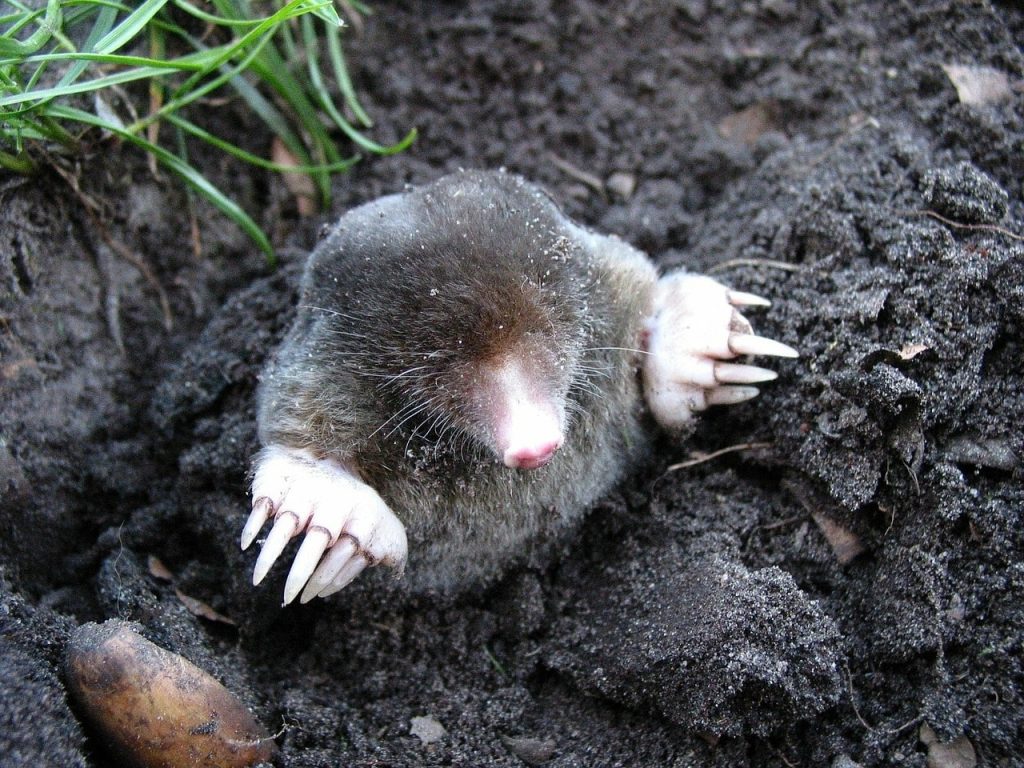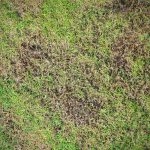If you’re constantly waking up to find holes in your garden, you might be wondering what exactly is digging them.
In this guide, we’ve explained what types of animals and insects might be digging holes in your garden in the UK. We’ve also explained how to tell what is digging up your garden.
Animals that dig holes in lawns at night
There are a number of different types of creatures that dig holes in lawns in the UK.
Here are some of the most common animals and insects that make holes, how to tell between different types of holes in your lawn, and how to deal with each type of animal.
1. Moles

Moles are very common in the UK, and often leave holes in your lawn. This occurs when they are digging new tunnels, and need somewhere to put the extra soil.
As a result, molehills can be quite large – up to six inches across, with a small 1-2 inch hole at the top. They look sort of like small mountains, and are quite easy to spot – they can be a bit of a trip hazard.

Moles do not hibernate, but they tend to go deeper underground and be less active during the winter. As the weather warms up again, they tend to be most active.
Dealing with moles
Moles can be quite beneficial to your lawn. They help with aeration and drainage, and also eat worms, grubs and other pests that may harm your lawn.
Getting rid of moles from your garden can be quite difficult, since they are so common, and live deep underground. Sometimes, it’s worth leaving them be, especially due to the benefits they bring.
However, if you have a serious mole problem, you could consider putting something that smells very bad down each mole hole. Since moles have a very good sense of smell, this can be a good way to deter them, if you do it consistently.
You can use dairy products such as stale milk or old cheese as a mole deterrent, as this will not damage your lawn.
2. Foxes

Foxes like to scavenge for food, and they may dig up your lawn in search of worms, grubs and other insects to eat.
If a fox is digging up your lawn, the holes won’t necessarily look the same size/shape. Instead, the grass and dirt will have been scraped back, sort of how a dog digs a hole. There may also be soil deposited around the hole.
Dealing with foxes
Depending on the type of garden you have, there are a number of ways to prevent foxes from digging up your lawn:
- Introduce smells that foxes don’t like, such as cayenne pepper or white vinegar.
- Make your garden perimeter more secure, by adding fences, and using wire mesh to cover any gaps at the bottom of fences.
- Remove obstacles from your garden – foxes like to have shelter nearby, so if your lawn is completely open, this can reduce the likelihood that they will inspect the middle of your grass.
3. Earthworms

If you’re noticing small piles of dirt on your lawn, it could be earthworms that are causing the issue.
Rather than digging a hole as such, earthworms create wormcasts – small mounds/mud balls, about 1-2 inches wide.
The annoying thing about wormcasts is they can be difficult to fill in, since there is no hole associated with them. You may also see hundreds of them appear at a time.
Dealing with earthworms
The best way to deal with earthworms is actually to have something else manage them for you. For example, badgers and moles both love to eat earthworms.
There is also a product available called CastClear, which is a natural worm deterrent. It doesn’t kill worms, but does discourage them from travelling through the soil.

Also, to reduce the number of wormcasts you’re seeing, you want to avoid watering the lawn too much. When the soil is extremely wet, worms need to come to the surface to breathe, creating wormcasts.
4. Badgers

Badgers love to eat plants, including flowers and fruit/vegetables. However, when they get desperate for food, they may also dig up your lawn in search of insects to eat.
Badger holes are quite large, similar to molehills, but they look less organised. They won’t all look the same.
You can tell you have badgers on your lawn if other plants, such as your vegetable patch or garden bed, are trampled during the night.
Dealing with badgers
Badgers are best managed by securing the perimeter of your garden, similar to how you prevent foxes from coming onto your grass.
It’s important to ensure there are no gaps in your fencing. If badgers are still able to get into your garden, look for signs that they are digging under your fence in certain places. Then, install wire mesh, including underground (about a metre deep) to keep the badgers at bay.
5. Voles

Voles are small rodents that look a lot like mice, except they have shorter tails. They like to run around the surface of your lawn, and may also dig underground as well.
If a vole digs a hole in your lawn, it will be about the size of a large marble. The hole will look like a burrow, and there may also be trenches running between the holes, about half an inch below the grass.
Dealing with voles
The best way to deal with voles is to keep your lawn nice and short. These rodents love long, unkempt grass, so that they have a place to hide.
Also, badgers hunt voles, as do owls and foxes. Their populations do not tend to last for a long time, so you may find that the number of voles may subside naturally over time.
To manage a severe vole problem, you can use regular mousetraps, baited with small chunks of apple.
6. Shrews

Shrews are sort of similar to voles, except they have a pointy nose, and do not grow as large. Also, shrews are much more beneficial for your lawn. They don’t dig trenches, unlike voles, and are quite helpful in dealing with insects and worms.
Shrews don’t normally dig holes in the middle of your lawn. They like to live in tunnels under rocks and patios – so you may notice small burrows in these locations.
Dealing with shrews
Most of the time, you don’t need to worry about shrews damaging your lawn. If there are holes and/or trenches in your grass, most of the time it’s voles that are causing the problem.
To manage shrew holes, you can move their shelter (such as large rocks) to other areas of your lawn.
You can also mow the lawn shorter, to ensure that they have no shelter on your grass.
7. Squirrels

Unlike most of the other animals on this list, squirrels are also active during the day, so you might be able to spot them at work, especially in the morning.
Squirrels can dig small holes in your lawn to store their nuts and acorns. They typically attempt to cover over the hole again, although the result is not normally perfect.
Therefore, squirrel holes look like dirt patches where the grass has been scraped away, with evidence of a small hole being dug.
Dealing with squirrels
To stop squirrels digging up your lawn, you want to avoid releasing any smells that might attract them to your garden in the first place. For example, don’t leave your bins open, and ensure that your rubbish bags are sealed. Also, try to keep pet food inside, or in your garage, rather than in the garden.
You should also rake the lawn regularly to clear the ground of food that squirrels like, such as acorns and seeds from trees.
8. Birds

Birds could also be digging in your lawn during the day, in search of food such as worms and grubs.
In this case, you will notice small holes in your lawn that have not been filled in. Typically, the bird will use its beak to dig, but it may also scrape with its feet to get to the soil.
Dealing with birds
If birds are digging at your lawn, this could be a sign that you have a pest problem, especially from grubs or larvae. Therefore, you may want to let the birds do their thing for a few weeks, until there is nothing left for them to eat.
However, if the birds are destroying your lawn, and there are no signs of them stopping, you may want to take action.
It can be quite difficult to prevent birds from entering your garden. Your best approach is to use a fake owl, or some other deterrent that looks like a predator.
The best way to prevent birds from digging up your grass is to restrict their food source. If there are no insects to feast on, there is no reason for birds to dig up the ground.
To manage earthworms, you want to keep the lawn relatively short, to reduce the likelihood of the worms coming to the surface, since they don’t like sunlight. But with more serious pests, such as grubs, you may want to consider using a pest control spray, before they begin to do damage to your lawn. You can find natural pesticide sprays that will help to eliminate these types of pests.
9. Cats

It’s also possible that your neighbour’s cat is digging holes in your lawn at night.
Cats dig holes to do their business, which makes them especially annoying. This can do significant damage to your lawn. However, typically they will prefer loose areas of soil around the edge of your garden, rather than the lawn itself.
If a cat is visiting your lawn, you will likely notice that small areas have been dug up and recovered. If you have a dog, he or she may also be attracted to the area that the cat has done its business.
Dealing with cats
If you know whose cat is visiting your lawn, for example from seeing it in the morning, you can discuss the problem with your neighbour, and ask that they keep control of their animal.
If you’d prefer to avoid doing this, or you don’t know whose cat it is, you want to introduce some smells that cats don’t like in the location it is digging holes. Lavender or cinnamon are a good place to start.
Conclusion
This is the end of our guide explaining what types of animals and insects might be digging in your garden in the UK.
If you’re still unsure what sort of animal you’re dealing with, and how best to manage the problem, feel free to leave us a comment below.

I’m Josh, and I’m the head writer at Lawn Care Pro.
I love everything lawns, but I’m a bit of a lawn mower nerd. I spend a lot of my free time tinkering with mowers, and planning my mowing schedule for the next few weeks.
I’m also into cars, which comes in very helpful when servicing a mower engine!





